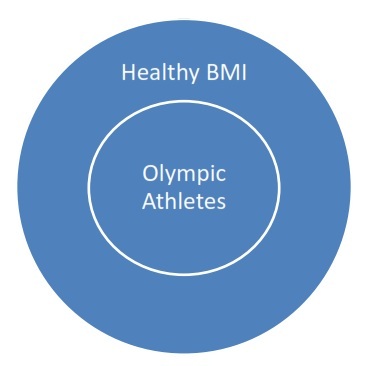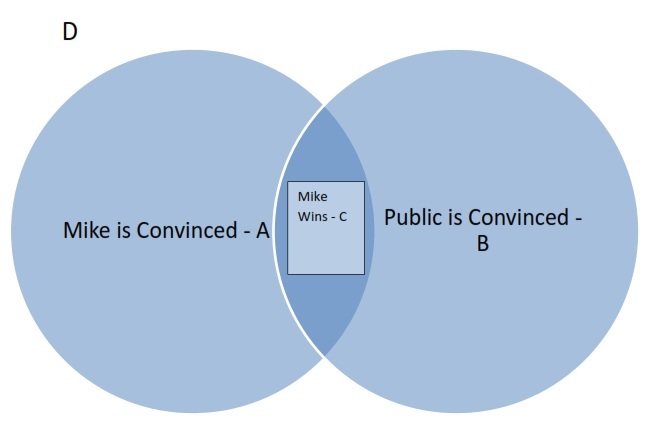
Confusing possibility with necessity on GMAT Critical Reasoning
Confusingbetween Possibility andNecessityon CR
In GMAT critical reasoning, there are several different types of questions that you will encounter. In this short article, we will cover the characteristics of questions that involve distinguishing between possibility and necessity.
Confusion between Possibility and Necessity
This error is said to occur when a “possible” condition is confused with a “necessary” condition; in other words, when a condition that
can happen is confused for one that
must happen.
Please take a look at the following example to better understand this concept.
Example 1:
Statement -
All Olympic athletes maintain a healthy body mass index.
Inference -
If Jack has a healthy body mass index, he is an Olympic athlete.
Can this inference be logically drawn? Let’s chart this information graphically.

From this, we can see that there are people who do have a healthy BMI, but are not Olympic athletes; in other words, “Olympic Athletes” is a subset of “People with Healthy BMI”. Thus, we know that “Jack” belongs to the set of “People with Healthy BMI”, but this does not mean that he belongs to the subset of “Olympic Athletes”. Thus, this inference is a possibility but not a necessity. So, this inference cannot be drawn.
Let us now take an expansive example – an argument with seven statements. Please consider each statement and mark it with a check if you think the statement must be true; otherwise, mark it with a cross.
Example 2:
Mike is an actor who played negative characters in many movies. He was considering contesting upcoming senate elections. He would contest only if he was convinced that his image of playing negative characters would not affect public perception of his ability to perform federal duties. Public majority would vote for him only if the majority was convinced about his ability to perform federal duties.
If each of the statements above is true, which (all) of the following MUST be true.
Statement 1:
If Mike is a senator today, he was convinced that his image of playing negative characters would not affect public perception of his ability to perform federal duties.
Statement 2:
If Mike is not a senator today, he was not convinced that his image of playing negative characters would not affect public perception of his ability to perform federal duties.
Statement 3:
If Mike is a Senator today, public majority was convinced about his ability to perform public duties.
Statement 4:
If Mike is not a senator today, public majority was not convinced about his ability to perform public duties.
Statement 5:
If Mike contested the senate elections, public majority was convinced about his ability to perform public duties.
Statement 6:
If Mike did not contest the senate elections, public majority was not convinced about his ability to perform public duties.
Statement 7:
If Mike contested the senate elections, he was convinced that his image of playing negative characters would not affect public perception of his ability to perform federal duties.
Let us, once again, represent the data graphically.

Here, “A” represents the set of circumstances wherein “Mike is Convinced” but the public is not convinced, and “B” represents the set of circumstances wherein “Public is convinced” but Mike is not convinced. Area “C” represents the set of circumstances wherein both Mike and the public are convinced; in these circumstances, we can say that “Mike Wins”. What this indicates is that for Mike to win the senate election, first, he must be convinced and then the public must be convinced. Area “D” represents the set of circumstances wherein neither Mike nor the public is convinced, meaning Mike does not contest the election at all.
Now, with the groundwork laid out, let’s take a look at the statements.
Statement 1:
If Mike is a senator today, he was convinced that his image of playing negative characters would not affect public perception of his ability to perform federal duties. – If Mike is a senator today, he won the election, meaning we are talking about area C; this means that Mike was convinced. Thus, this statement must be true.
Statement 2:
If Mike is not a senator today, he was not convinced that his image of playing negative characters would not affect public perception of his ability to perform federal duties. - If Mike is not a senator today, this circumstance must lie in area A, B, or D. The statement that Mike was not convinced is true in areas B and D but not in A. Thus, since there is a set of circumstances wherein Mike is convinced but is not a senator today, this statement need not be true.
Statement 3:
If Mike is a Senator today, public majority was convinced about his ability to perform public duties. - If Mike is a senator today, he won the election, meaning we are talking about area “C”; this means that the public was convinced. Thus, this statement must be true.
Statement 4:
If Mike is not a senator today, public majority was not convinced about his ability to perform public duties. If Mike is not a senator today, this circumstance must lie in area A, B, or D. The statement that the public was not convinced is true in areas A and D but not in B. Thus, since there is a set of circumstances wherein the public is convinced but Mike is not a senator today, this statement need not be true.
Statement 5:
If Mike contested the senate elections, public majority was convinced about his ability to perform public duties. – If Mike contested the elections, this circumstance must lie in area A or C. The statement that the public was convinced is true in area C but not in area A. Thus, since there is a set of circumstances wherein Mike contests the election but the public is not convinced, this statement need not be true.
Statement 6:
If Mike did not contest the senate elections, public majority was not convinced about his ability to perform public duties. - If Mike did not contest the elections, this circumstance must lie in area B or D. The statement that the public was not convinced is true in area D but not in area B. Thus, since there is a set of circumstances wherein Mike did not contest the election but the public was convinced, this statement need not be true.
Statement 7:
If Mike contested the senate elections, he was convinced that his image of playing negative characters would not affect public perception of his ability to perform federal duties. – If Mike was convinced, this set of circumstances must lie in are A or C. In both these areas, Mike was convinced, meaning this statement must be true.
All of the statements here that need not be true make the error of confusing possibility with necessity.
This article has deliberately been kept brief; for a more elaborate explanation, please refer to the Experts’ Global Stage One Critical Reasoning videos.

